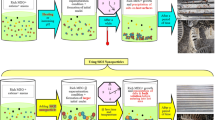Abstract
In the graphite oxide (GO) suspension purification process, some metallic impurities in GO cannot be separated. The residual metallic impurities dominate graphite oxide properties and have a negative influence on applications. Therefore, the removal of metallic impurities from graphite oxide has been brought into focus now. Single factor experiments and orthogonal experiments are used to get the optimal purification condition. The results show that purification agent, temperature, stirring intensity and contact time affect the purification degree, and the purification agent is the most important element for the purification efficiency. The optimal purification condition is 10% hydrochloric acid (H10), 20 °C, 0 rpm and 60 min. Besides, the theoretical stage is calculated by the mass conservation equation and distribution balance equation and the minimum stage is 3 under the optimal purification condition.
Similar content being viewed by others
References
B. C. Brodie, J. Franklin. I., 59, 420 (1855).
I. R. Mar and G. J. Valer, Carbon, 24, 163 (1986).
W. S. Hummers and R. E. Hoffman, J. Am. Chem. Soc., 80, 1339 (1958).
M. J. Hudson, F. R. Hunter and J. W. Peckett, J. Mater. Chem., 7, 301 (1997).
A. Adriano, Y. C. Sze, K. Bahareh, D. W. Richard, S. Zdene and P. Martin, Angew. Chem. Int. Edit., 51, 500 (2012).
J. A. Matthew, C. T. Vincent and B. K. Richard, Chem. Rev., 110, 132 (2010).
S. W. Kim and H. M. Choi, Korean J. Chem. Eng., 33, 330 (2016).
J. A. Rogers, Nat. Nanotechnol., 3, 254 (2008).
M. Pumera, Chem. Soc. Rev., 39, 4146 (2010).
A. Ambrosi and M. Pumera, Chem. Eur. J., 16, 1786 (2010).
L. Guo, D. G. Morris, X. Y. Liu, C. Vaslet, R. H. Hurt and A. B. Kane, Chem. Mater., 19, 3472 (2007).
X. L. Tian, S. Zhou, Z. Y. Zhang, X. He, M. J. Yu and D. H. Lin, Environ. Sci. Technol., 44, 8144 (2010).
S. Koyama, Y. A. Kim, T. Hayashi, K. Takeuchi, C. Fujii, N. Kuroiwa, H. Koyama, T. Tsukahara and M Endo, Carbon, 47, 1365 (2009).
S. L. Buchwald and C. Bolm, Angew. Chem., 121, 5694 (2009).
M. Pumera and Y. Miyahara, Nanoscale, 1, 260 (2009).
G. Zhao, J. Li, X. Ren, C. Chen and X. Wang, Environ. Sci. Technol., 45, 10454 (2011).
W. Jia and S. Lu, Korean J. Chem. Eng., 31, 1265 (2014).
M. A. Atieh, O. Y. Bakather, B. S. Tawabini, A. A. Bukhari, M. Khaled, M. Alharthi, M. Fettouhi and F. A. Abuilaiwi, J. Nanomater, 210, 9. (2010).
M. Machida, T. Mochimaru and H. Tatsumoto, Carbon, 44, 2681, (2006).
J. H. Liao, Y. Zhang, W. Yu, L. N. Xu, C. W. Ge, J. H. Liu and N. Gu, Colloids Surf., A, 223, 177 (2003).
P. Galletto, P. F. Brevet and H. H. Girault, J. Phys. Chem. B., 103, 8706 (1999).
Y. Bian, Z. Y. Bian, J. X. Zhang, A. Z. Ding, S. L. Liu and H. Wang, Appl. Surf. Sci., 329, 269 (2015).
Y. Li, C. L. Wang, Z. J. Guo, C. L. Liu and W. S. Wu, J. Radioanal. Nucl. Chem., 299, 1683 (2014).
C. H. Chen, Q. H. Yang, Y. G. Yang, W. Lv, Y. F. Wen, P. X. Hou, M. Z. Wang and H. M. Cheng, Adv. Mater., 21, 3007 (2009).
K. H. Ryu, C. Lee, G. G. Lee, S. Jo and W. S. Su, Korean J. Chem. Eng., 30, 1946 (2013).
Author information
Authors and Affiliations
Corresponding author
Rights and permissions
About this article
Cite this article
Tan, W., Liu, Y., Liu, L. et al. Optimization of operating conditions in the purification of graphite oxide dispersions. Korean J. Chem. Eng. 33, 3251–3257 (2016). https://doi.org/10.1007/s11814-016-0164-9
Received:
Accepted:
Published:
Issue Date:
DOI: https://doi.org/10.1007/s11814-016-0164-9




